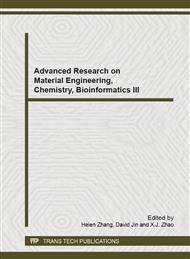[1]
Suman , A. Kumar: S. &T. Vol. 92(2008), p.122.
Google Scholar
[2]
S. K. Sharma, N. Sehgal, A. Kumar: Curr. Appl. Phys. Vol. 3(2003), p.307.
Google Scholar
[3]
M. Yin, C. Wu, L. Shao, W. Chan, A. Zhang, C. Lu, H. Tam: Analyst, 2013, 138, 1988-(1994).
Google Scholar
[4]
H. Peng, L. Zhang, C. Soeller, J. Travas-Sejdic: Biomaterials. Vol. 30(2009), p.2132.
DOI: 10.1016/j.biomaterials.2008.12.065
Google Scholar
[5]
S. Siddiquee, N. A. Yusof, A. B. Salleh, S. G. Tan, F. Abu Bakar: J. Solid State Electrochem. Vol. 16(2012), p.273.
Google Scholar
[6]
M. Silvestrini, L. Fruk, P. Ugo: Biosens. Bioelectron. Vol. 40(2013), p.265.
Google Scholar
[7]
Y. Shao, J. Wang, H. Wu, J. Liu, I. A. Aksay, Y. Lin: Electroanal. Vol. 22(2010), p.1027.
Google Scholar
[8]
S. Licht, N. Myung, Y. Sun: Anal. Chem. Vol. 68(1996), p.954.
Google Scholar
[9]
Y. Jia, X. -B. Yin, J. Zhang, S. Zhou, M. Song, K. -L. Xing: Analyst. Vol. 137(2012), p.5866.
Google Scholar
[10]
Y. Xu, Z. Liu, X. Zhang, Y. Wang, J. Tian, Y. Huang, Y. Ma, X. Zhang, Y. Chen: Adv. Mater. Vol. 21(2009), p.1275.
Google Scholar
[11]
Y. Ohno, K. Maehashi, Y. Yamashiro, K. Matsumoto: Nano letters. Vol. 9(2009), p.3318.
Google Scholar
[12]
Y. Zhu, S. Murali, W. Cai, X. Li, J. W. Suk, J. R. Potts, R. S. Ruoff, Adv. Mater. 2010, 22, 3906-3924.
DOI: 10.1002/adma.201001068
Google Scholar
[13]
Q. He, H. G. Sudibya, Z. Yin, S. Wu, H. Li, F. Boey, W. Huang, P. Chen, H. Zhang: ACS Nano. Vol. 4(2010), p.3201.
Google Scholar
[14]
H. J. Shin, K. K. Kim, A. Benayad, S. M. Yoon, H. K. Park, I. S. Jung, M. H. Jin, H. K. Jeong, J. M. Kim, J. Y. Choi: Adv. Funct. Mater. Vol. 19(2009), p. (1987).
Google Scholar
[15]
K. -H. Liao, A. Mittal, S. Bose, C. Leighton, K. A. Mkhoyan, C. W. Macosko: ACS Nano. Vol. 5, p.1253.
Google Scholar
[16]
D. Li, M. B. Müller, S. Gilje, R. B. Kaner, G. G. Wallace: Nat. Nanotechnol. Vol. 3(2008), p.101.
Google Scholar
[17]
S. Park, J. An, R. D. Piner, I. Jung, D. Yang, A. Velamakanni, S. T. Nguyen, R. S. Ruoff: Chem. Mater. Vol. 20(2008), p.6592.
Google Scholar
[18]
X. Fan, W. Peng, Y. Li, X. Li, S. Wang, G. Zhang, F. Zhang: Adv. Mater. Vol. 20(2008), p.4490.
Google Scholar
[19]
S. Park, J. An, I. Jung, R. D. Piner, S. J. An, X. Li, A. Velamakanni, R. S. Ruoff: Nano letters. Vol. 9 (2009), p.1593.
Google Scholar
[20]
S. Stankovich, D. A. Dikin, R. D. Piner, K. A. Kohlhaas, A. Kleinhammes, Y. Jia, Y. Wu, S. T. Nguyen, R. S. Ruoff: Carbon. Vol. 45(2007), p.1558.
DOI: 10.1016/j.carbon.2007.02.034
Google Scholar
[21]
K. A. Mkhoyan, A. W. Contryman, J. Silcox, D. A. Stewart, G. Eda, C. Mattevi, S. Miller, M. Chhowalla: Nano Lett. Vol. 9(2009), p.1058.
DOI: 10.1021/nl8034256
Google Scholar
[22]
D. R. Dreyer, S. Park, C. W. Bielawski, R. S. Ruoff: Chem. Soc. Rev. Vol. 39(2010), p.228.
Google Scholar
[23]
Y. Dan, Y. Lu, N. J. Kybert, Z. Luo, A. C. Johnson: Nano letters. Vol. 9(2009), Vol. 1472.
Google Scholar
[24]
T. -Y. Chen, P. T. K. Loan, C. -L. Hsu, Y. -H. Lee, J. Tse-Wei Wang, K. -H. Wei, C. -T. Lin, L. -J. Li: Biosen. & Bioelec. Vol. 41(2012), Vol. 103.
Google Scholar
[25]
X. Dong, Y. Shi, W. Huang, P. Chen, L. J. Li: Adv. Mater. Vol. 22(2010), p.1649.
Google Scholar
[26]
T. Cohen-Karni, Q. Qing, Q. Li, Y. Fang, C. M. Lieber: Nano letters. Vol. 10(2010), p.1098.
Google Scholar
[27]
S. Mao, G. Lu, K. Yu, Z. Bo, J. Chen: Adv. Mater. Vol. 22(2010), p.3521.
Google Scholar
[28]
C. Wu, Y. Zhou, X. Miao, L. Ling: Analyst. Vol. 136(2011), p.2106.
Google Scholar
[29]
L. Cui, X. Lin, N. Lin, Y. Song, Z. Zhu, X. Chen, C. J. Yang, Chem. Commun. Vol. 48(2012), p.194.
Google Scholar
[30]
J. -J. Liu, X. -R. Song, Y. -W. Wang, G. -N. Chen, H. -H. Yang: Nanoscale. Vol. 4(2012), p.3655.
Google Scholar
[31]
X. Sun, Z. Liu, K. Welsher, J. T. Robinson, A. Goodwin, S. Zaric, H. Dai: Nano Res. Vol. 1(2008), p.203.
Google Scholar
[32]
G. Eda, G. Fanchini, M. Chhowalla: Nat. Nanotechnol., Vol. 3(2008), p.270.
Google Scholar



